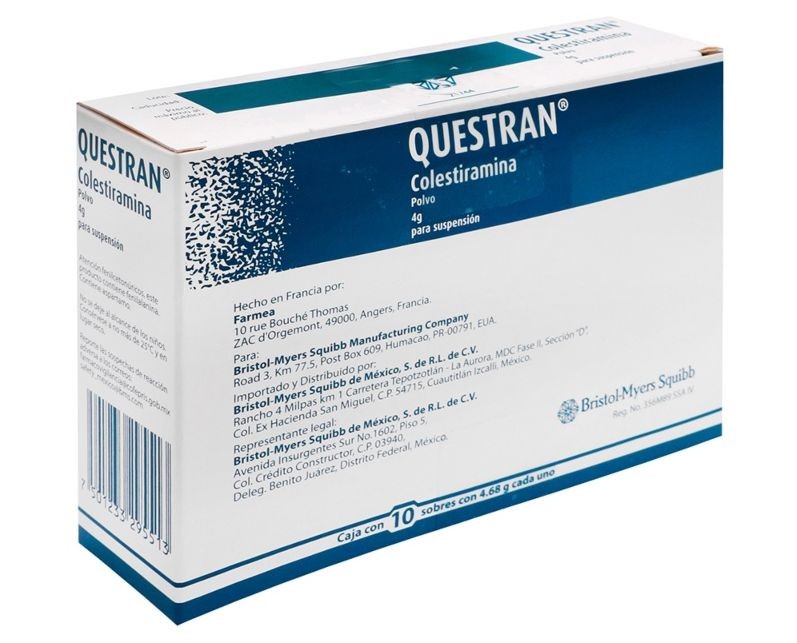
Contents
Side Effects of Questran (cholestyramine)
Questran (cholestyramine) is a cholesterol-lowering agent used to reduce cholesterol levels in the blood, relieve itching of liver and biliary disease, and treat overdoses of digoxin or thyroid hormone. It is also recommended for the rapid elimination of leflunomide.
Cholesterol ingested or manufactured in the body is eliminated through conversion to bile acids in the liver and excretion into the intestine with bile. Bile acids are reabsorbed from the intestine and removed from the blood by the liver. Questran binds to bile acids in the intestine, preventing their absorption and resulting in elimination in the stool. This leads to a loss of bile acids, causing the liver to increase the conversion of cholesterol to bile acids.
The conversion of cholesterol to bile acids reduces body cholesterol levels and lowers cholesterol in the blood. Itching is a troubling symptom for patients with liver and biliary disease, believed to be caused by the accumulation of bile acids in the skin. Questran binds bile acids, hastening their elimination from the body and skin, and improving itching. It also binds some drugs in the intestine, preventing their absorption and hastening their elimination, making it useful in cases of drug overdose.
Common side effects of Questran include gastric ulcer, gastrointestinal bleeding, and deficiency of vitamins A, D, E, and K with long-term use.
Questran interacts with warfarin, thyroid hormones, digoxin, and thiazide diuretics, decreasing their absorption. These drugs should be administered 1 hour before or 4-6 hours after the administration of Questran. Questran decreases the conversion of leflunomide to its active form and reduces the absorption of vitamin A, D, E, and K.
The use of Questran in pregnant women has not been adequately evaluated. Since Questran is not absorbed into the bloodstream, the risk of adverse effects on the fetus is likely low. However, it may lead to a decrease in the concentration of vitamins A, D, E, and K in the mother’s milk, potentially causing vitamin deficiency in the infant. Consult your doctor before breastfeeding.
Common Side Effects of Questran (cholestyramine)
- constipation
- abdominal pain
- bloating
- vomiting
- diarrhea
- belching
- gallstones
- weight loss
- excessive gas (flatulence)
Other side effects include discolored teeth, gastric ulcer, and gastrointestinal bleeding. Long-term use may cause deficiency of vitamins A, D, E, and K. To prevent constipation, additional fluids should be consumed and more aggressive treatment such as fiber, stool softeners, or laxatives may be necessary.
Questran (cholestyramine) Side Effects for Healthcare Professionals
The most common adverse reaction is constipation. Predisposing factors for most complaints of constipation are high dose and increased age. Instances of constipation are usually mild, transient, and controlled with conventional therapy. Some patients may require a temporary decrease in dosage or discontinuation of therapy.
Less frequent adverse reactions include abdominal discomfort and/or pain, flatulence, nausea, vomiting, diarrhea, eructation, anorexia, steatorrhea, bleeding tendencies due to hypoprothrombinemia, deficiencies of vitamins A and D, hyperchloremic acidosis, osteoporosis, rash, irritation of the skin, tongue, and perianal area. Rare reports of intestinal obstruction have been observed in pediatric patients.
Calcified material has been observed in the biliary tree, including calcification of the gallbladder, in patients taking Questran. However, this may be a manifestation of liver disease and not drug-related.
Other events reported in patients taking Questran include gastrointestinal bleeding, changes in liver function tests, prolonged prothrombin time, ecchymosis, anemia, urticaria, asthma, wheezing, shortness of breath, backache, muscle and joint pains, arthritis, headache, anxiety, vertigo, dizziness, fatigue, tinnitus, syncope, drowsiness, femoral nerve pain, paresthesia, uveitis, hematuria, dysuria, burnt odor to urine, diuresis, weight loss, weight gain, increased libido, swollen glands, edema, dental bleeding, dental caries, erosion of tooth enamel, and tooth discoloration.
Drug Interactions with Questran (cholestyramine)
- Questran may delay or reduce the absorption of concomitant oral medication such as phenylbutazone, warfarin, thiazide diuretics, propranolol, tetracycline, penicillin G, phenobarbital, thyroid and thyroxine preparations, estrogens and progestins, and digitalis.
- Questran may interfere with the absorption of oral phosphate supplements and drugs undergoing enterohepatic circulation.
- The discontinuance of Questran could pose a hazard if a potentially toxic drug such as digitalis has been titrated to a maintenance level while taking Questran.
- Questran may interfere with normal fat digestion and absorption, preventing the absorption of fat-soluble vitamins A, D, E, and K. Supplementation with water-miscible forms of fat-soluble vitamins should be considered with long-term use.
To avoid impeding the absorption of other drugs, it is recommended that patients take other drugs at least one hour before or 4-6 hours after Questran.
Summary
Questran (cholestyramine) is a cholesterol-lowering agent used to reduce cholesterol levels in the blood, relieve itching of liver and biliary disease, and treat overdoses of digoxin or thyroid hormone. Common side effects of Questran include constipation, abdominal pain, bloating, vomiting, diarrhea, belching, gallstones, weight loss, excessive gas (flatulence), and discolored teeth. Use of Questran in pregnant women has not been adequately evaluated. Questran could lead to a decrease in the concentration of vitamins A, D, E, and K in the mother’s milk and potentially cause vitamin deficiency in the infant.


